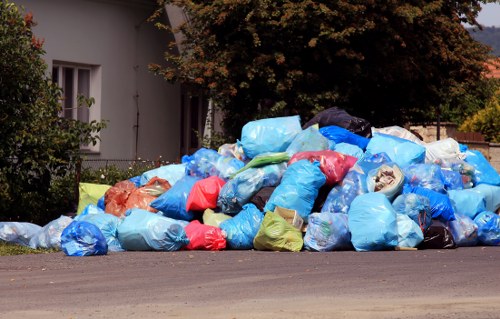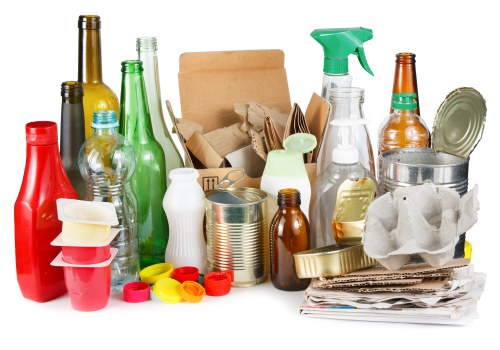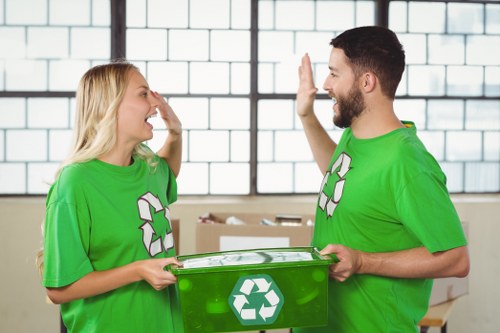Waste Recycling in Office Clear: Enhancing Sustainability in Workspaces
Introduction to Waste Recycling in Office Clear

Waste Recycling in Office Clear is an essential practice in modern work environments. As businesses evolve, the importance of sustainability has led many to adopt effective waste recycling systems that not only help reduce environmental impact, but also promote eco-friendly practices in the workplace. In today’s competitive market, offices that employ robust recycling strategies witness improved productivity and morale, while also presenting a positive public image.
Recycling in an office setting involves careful sorting, handling, and repurposing of waste materials to ensure that fewer resources are disposed of in landfills. This process can engage employees, instilling a sense of responsibility and commitment towards reducing waste. In essence, embracing recycling initiatives can provide tangible benefits, including cost-saving measures and a wake-up call to environmental sustainability.
Furthermore, the integration of waste recycling systems into office clear environments can be viewed as a strategic move. Businesses that lead by example in recycling promote responsible behavior, both internally and externally. Organizational leaders are encouraged to stay updated with innovative waste management techniques, reinforcing the idea that a cleaner office is a productive and profitable workspace.
The Economic and Environmental Benefits of Office Recycling

Waste recycling in office clear initiatives create a win-win scenario for companies. Economically, reducing waste production minimizes disposal costs and can even convert waste into valuable resources through partnerships with recycling companies. This financial incentive is often paired with environmental benefits, as the reduced landfill usage helps to lower harmful emissions and contributes to overall ecosystem stability.
Implementing a recycling program in an office environment also fosters green innovation. Employees are encouraged to think critically about resource usage, which can lead to innovative approaches to reduce the office's carbon footprint. By adopting creative waste management techniques, businesses showcase their commitment to sustainability, positioning themselves as industry pioneers in corporate responsibility.
Moreover, effective recycling strategies directly influence customer perceptions. Companies that transparently communicate their recycling practices and sustainable initiatives tend to garner increased customer loyalty and trust, directly impacting their market reputation and potential revenue streams.
Understanding Waste Streams and Office Recycling Systems

To create an impactful waste recycling program, it is important to first understand the types of waste generated in office environments. Common office waste streams include paper, plastics, metals, electronic waste, and organic material. Each of these waste categories requires specific handling and processing techniques. Understanding these streams enables organizations to tailor their recycling processes to maximize efficiency and resource recovery.
Companies are increasingly integrating smart recycling solutions that use technology to monitor waste production and separation. Recycling in Office Clear can greatly benefit from digital tracking systems that provide real-time data on waste metrics. These systems not only support accountability but can also serve as educational tools to encourage sustainable behaviors among employees.
The adoption of an organized waste recycling system helps in identifying potential improvements. For example, by analyzing data on paper and plastic use, offices can modify purchasing decisions and waste management practices. Regular audits help in refining these processes, ensuring that waste reduction becomes a continuous objective rather than a one-time effort.
Developing a Comprehensive Office Recycling Strategy

Building an effective office recycling strategy requires detailed planning and commitment at all organizational levels. The first step involves an in-depth assessment of the current waste management practices. This analysis should highlight areas where improvements can be made, and recommend tailor-made adjustments based on the unique needs of the office environment.
Next, implementing training sessions and workshops for employees is crucial. Employee engagement is key to the success of any recycling program. By educating staff on how to properly dispose of waste and the benefits of recycling, companies can ensure their initiatives are widely adopted. A well-informed workforce is better equipped to participate actively in the organization’s sustainability drive.
In addition, leveraging industry expertise by collaborating with environmental consultants can enhance the effectiveness of waste recycling in office clear spaces. These experts can offer insights on advanced recycling techniques, innovative sorting systems, and best practices from leading organizations in waste management.
Sustainable Waste Reduction Techniques in Modern Offices

Modern offices are taking innovative steps towards sustainable waste reduction through a combination of traditional and advanced recycling practices. Initiatives like digital documentation to reduce paper waste, the use of biodegradable materials, and promoting a paperless culture have become popular. This transformation not only helps in reducing waste, but also contributes to the digital evolution of corporate communication.
Another emerging trend is the use of waste-to-energy technology. Office clear facilities can partner with local municipalities or recycling facilities that convert recyclable waste components into energy. This not only eases the burden on conventional energy sources but also reinforces the office’s commitment to renewable energy initiatives.
Furthermore, the promotion of reuse and repurposing programs is on the rise. Offices can set up internal donation channels where surplus equipment, furniture, or unused supplies are redistributed instead of being discarded. Such practices not only reduce waste but also enhance resource efficiency.
The Role of Technology in Enhancing Office Recycling Protocols
Technological advancements have redefined the landscape of waste recycling in office clear environments. Tools such as smart bins, recycling apps, and IoT-enabled waste management systems help to monitor and optimize recycling activities. These technologies provide valuable data that enable companies to track performance, identify patterns, and make informed decisions on further waste reduction.
An important technological development is the incorporation of artificial intelligence in sorting waste materials. AI-driven recycling bins are capable of distinguishing different waste types, ensuring that each item is collected and processed correctly. This reduction in manual sorting minimizes errors, increases efficiency, and ultimately leads to a more sustainable waste management system.
In addition, platforms that provide analytics on waste production can be seamlessly integrated with existing office management systems. This integration supports continuous improvement, as companies can set benchmarks and goals over time. Monitoring waste disposal trends becomes a proactive measure in optimizing recycling practices.
Building a Culture of Sustainability: Involving Every Employee
For waste recycling in office clear environments to succeed, it is essential to foster a culture of sustainability. The passion for environmental conservation must trickle down from top management to every employee. This kind of culture not only improves recycling practices but also enhances overall workplace morale. Encouraging team initiatives and inter-departmental competitions can generate enthusiasm and active participation in recycling efforts.
Employee empowerment in waste management processes is key. Offices can initiate internal campaigns that emphasize the importance of recycling through engaging activities such as sustainability challenges, monthly reviews, or reward programs. Simple measures, like strategic reminders and informative posters, can significantly boost participation rates.
Furthermore, creating a shared vision around sustainability can encourage cross-functional teams to work together on innovative recycling projects. When employees see the positive impact of their actions on both the environment and the company’s bottom line, they become more dedicated to maintaining robust recycling practices.
Challenges and Solutions in Establishing Office Recycling Programs
Implementing waste recycling in office clear environments is not without its challenges. One of the primary hurdles includes employee resistance due to lack of awareness or misunderstanding of recycling protocols. Overcoming these challenges requires dedicated training programs and clear communication of the recycling process.
Another challenge that organizations face is the physical infrastructure required for waste separation. Offices might need to redesign workspaces to incorporate designated recycling stations and ensure that waste collection is streamlined. This may initially require a financial investment, but the long-term benefits far outweigh the expenses involved.
Furthermore, tracking the effectiveness of recycling efforts can be difficult without the proper monitoring systems. To address this, companies should invest in emerging technologies that provide real-time feedback on recycling performance. These systems not only track waste volumes, but also assess employee participation and identify areas that need improvement.
Effective Policies and Guidelines for Office Recycling
An essential part of maintaining a successful waste recycling initiative is the development of clear and concise policies that outline the roles and responsibilities of every employee. These guidelines should clearly state what materials can be recycled and how to ensure that waste is segregated properly.
Below is an example of key points that could be included in an office recycling policy:
- Clear Signage: Use distinct labels and color codes for different recycling bins.
- Regular Training Sessions: Hold periodic training to update employees on new recycling practices.
- Scheduled Waste Audits: Conduct regular audits to ensure compliance and to track progress.
- Feedback Mechanisms: Utilize suggestion boxes for employees to provide ideas on improving recycling methods.
Implementing comprehensive guidelines ensures that every team member is aligned towards the goal of effective recycling. This further cements the concept of awareness, accountability, and sustained improvement within office clear frameworks.
Real-World Examples: Success Stories in Office Recycling
Several corporations have successfully integrated waste recycling programs into their office routines, setting benchmarks for others to follow. These success stories often highlight the importance of leadership, employee engagement, and the strategic use of technology in achieving sustainability goals.
A notable example includes a multinational firm that revamped its waste management policy. By installing smart waste bins and launching an internal recycling campaign, the firm reduced paper waste by over 40% within one year. This not only cut down disposal costs but also improved the company’s sustainability index.
In another instance, a medium-sized enterprise encouraged its workforce to participate in waste reduction competitions. Employees who contributed significantly to recycling efforts were recognized and rewarded. The initiative fostered teamwork and showcased how collective individual efforts can lead to substantial environmental benefits.
Sustainable Innovation: Future Trends in Office Recycling
The future of waste recycling in office clear environments looks promising with continuous advancements in sustainable technologies. There is growing interest in zero-waste initiatives, where every piece of waste is either reused, recycled, or repurposed. This ambitious goal demands ongoing innovation and reassessment of current recycling methods.
Future trends in office recycling include the rise of closed-loop systems where the waste generated in one cycle is reused in another. As more businesses commit to green practices, the integration of these advanced recycling systems could revolutionize how offices handle waste.
Additionally, the adoption of biodegradable office supplies and solar-powered recycling kiosks is expected to become more widespread. Companies are exploring partnerships with startups and technology firms to pilot cutting-edge solutions, ensuring that waste recycling in office clear environments not only remains relevant but reaches new levels of efficiency and sustainability.
Implementing Change: A Step-by-Step Guide to Enhance Office Recycling
Transitioning to an effective waste recycling system in office clear settings involves taking incremental, well-planned steps. First, conduct an in-depth assessment of current waste practices. This audit should help identify areas where waste is generated inefficiently and highlight opportunities for improved recycling management.
Next, set clear, measurable objectives for improvement. Goals may include reducing paper usage, increasing the percentage of recycled materials, or minimizing overall waste output. By establishing these benchmarks, companies can methodically work towards sustainability while tracking progress with regular performance reviews.
After formulating the plan, rolling it out across the organization should involve clear communication to all staff members. Workshops, training sessions, and visual aids such as posters and digital signage can ensure that everyone understands their role in maintaining a robust recycling program. Contact us today or book your service now if you need guidance on implementing these initiatives.
Developing Partnerships for Enhanced Office Recycling
Collaboration with external organizations can play a pivotal role in the success of waste recycling in office clear environments. Businesses can partner with specialized recycling firms, local governments, or environmental NGOs to benefit from broader expertise and resources. These partnerships often help optimize recycling procedures and provide additional support and training to employees.
For example, partnerships with certified recycling companies provide access to advanced sorting technologies and logistics solutions. By integrating these external services, offices can streamline their waste processing, ensuring that materials are diverted efficiently from landfills. Moreover, these collaborations often lead to shared best practices and innovative recycling solutions tailored to complex office environments.
Leveraging partnerships not only strengthens waste recycling efforts but also enhances a company’s corporate social responsibility profile. It sends a powerful message to clients and stakeholders that the organization is dedicated to sustainable practices and environmental stewardship.
Measuring the Success of Office Recycling Initiatives
It is crucial to measure the outcomes of any recycling initiative to understand its effectiveness. Regular monitoring and evaluation allow organizations to adjust strategies and boost efficiency. Key performance indicators can include waste diversion rates, employee participation, reduction in resource usage, and cost savings generated from reduced waste management expenses.
Data collection is facilitated by technological tools such as sensors and recycling tracking apps. These tools can track the volume of waste generated, providing quantitative insights that help in assessing the success of recycling programs. Effective data-driven strategies also help in setting realistic targets and recognising areas that need further improvement.
Finally, transparent reporting of progress is important. Organizations that share their sustainability successes build credibility and foster trust among employees, customers, and the wider community. Regular updates and internal reports also serve as a reminder of the shared commitment to environmental responsibility.
Call to Action and Future Outlook
Waste recycling in office clear settings is not just an environmental necessity—it is a dynamic opportunity to innovate, reduce costs, and promote a positive workplace culture. As more companies adopt these best practices, the collective impact on the environment can be profound. Businesses are encouraged to continuously seek improvements and embrace emerging technologies that further enhance recycling efficiency.
Looking ahead, the integration of eco-friendly policies will continue to redefine modern office practices. Efforts to minimize waste and promote sustainability will no doubt inspire further innovations and solidify the role of recycling in the corporate culture. The journey towards a sustainable workplace is ongoing, and every small step counts.
If you are ready to transform your office into an eco-friendly environment and maximize the benefits of waste recycling, contact us today for expert advice and personalized recycling solutions. Book your service now and join the movement towards a cleaner, greener future in office clear environments.